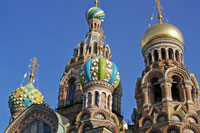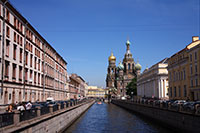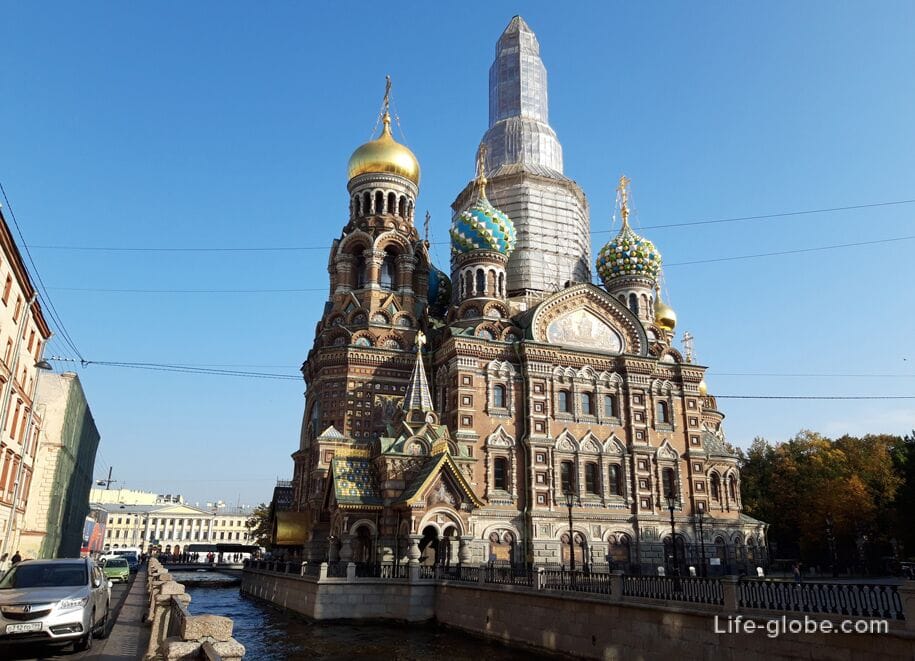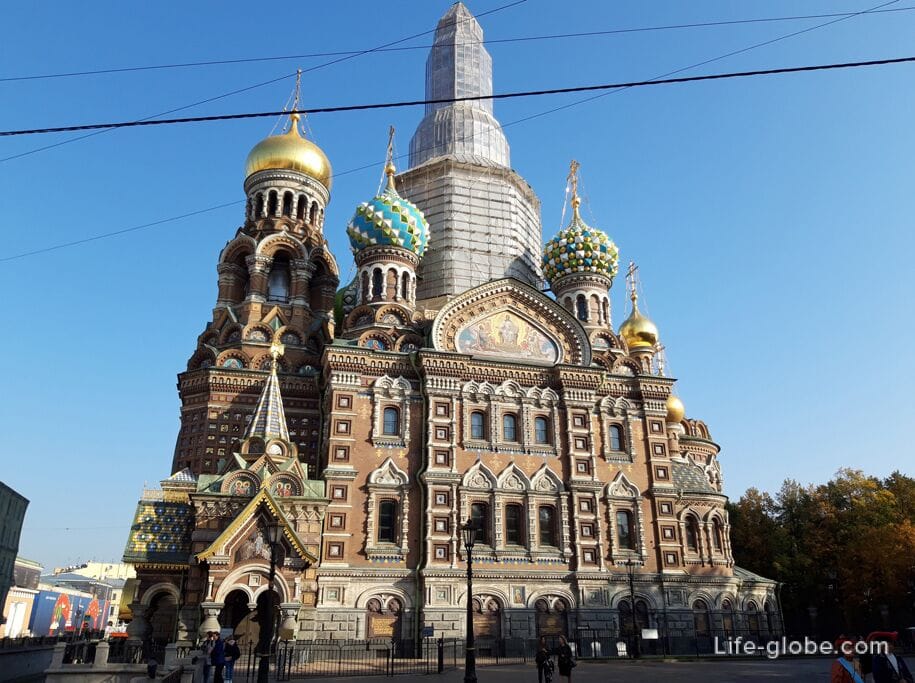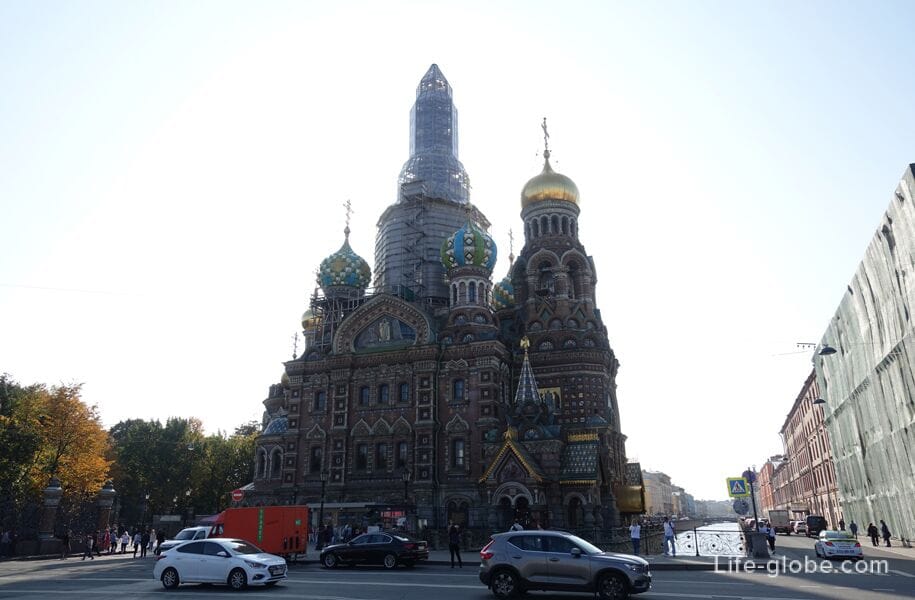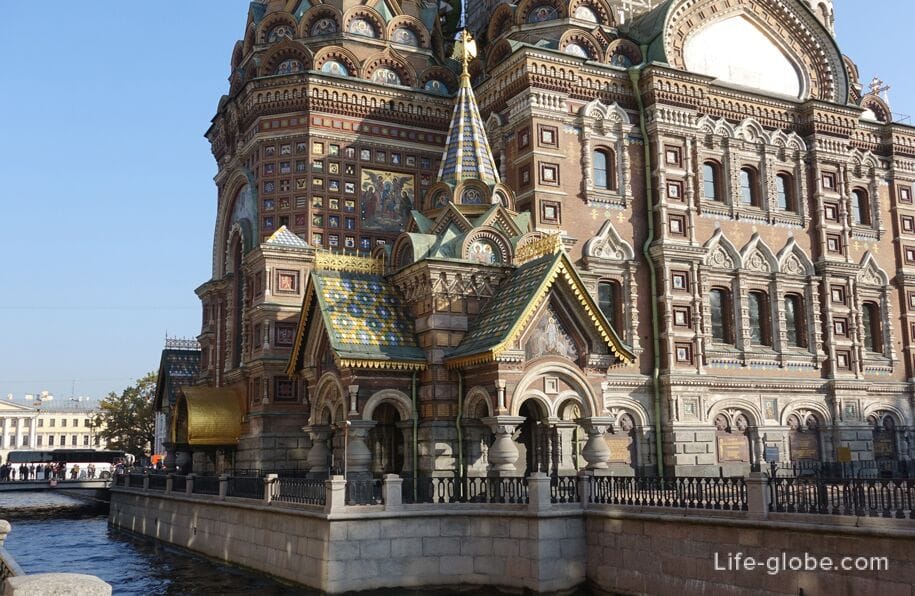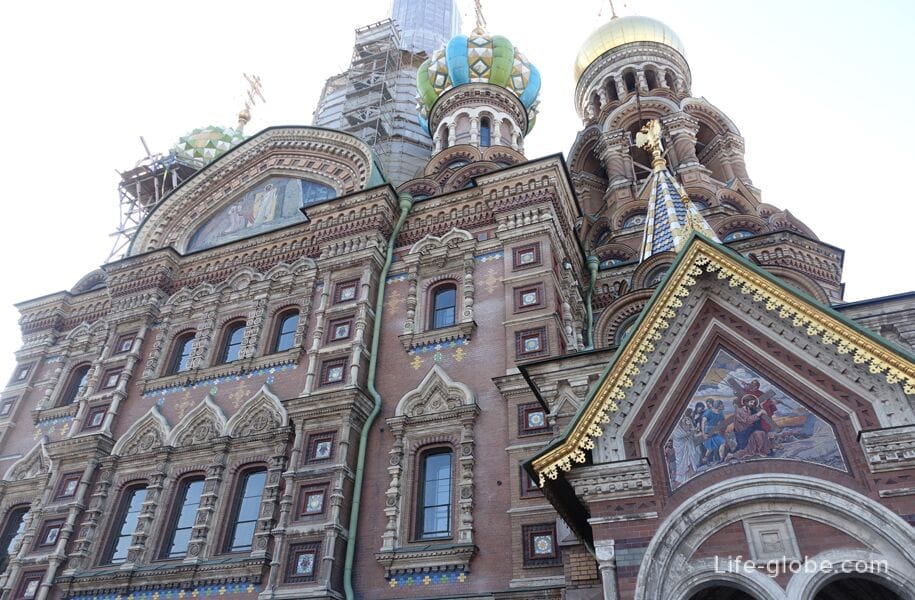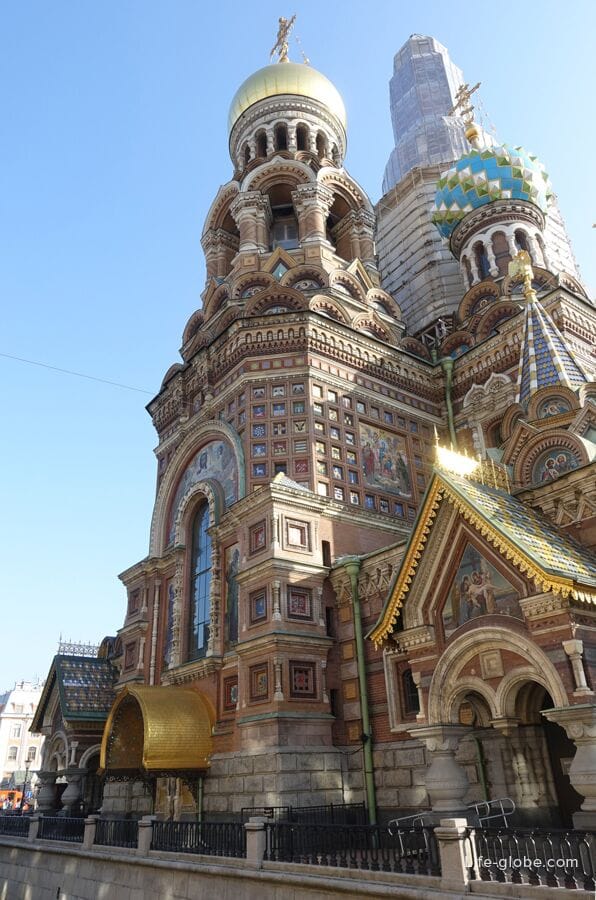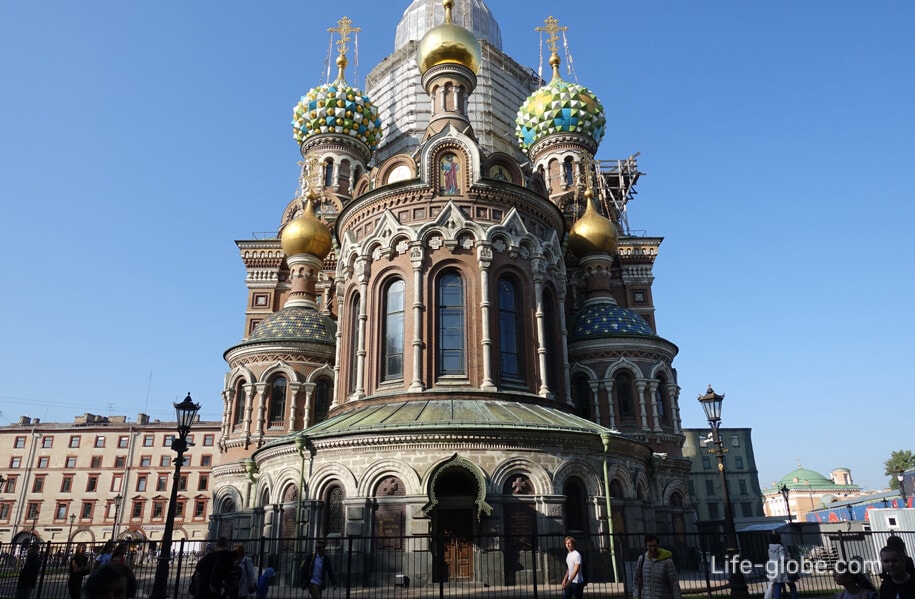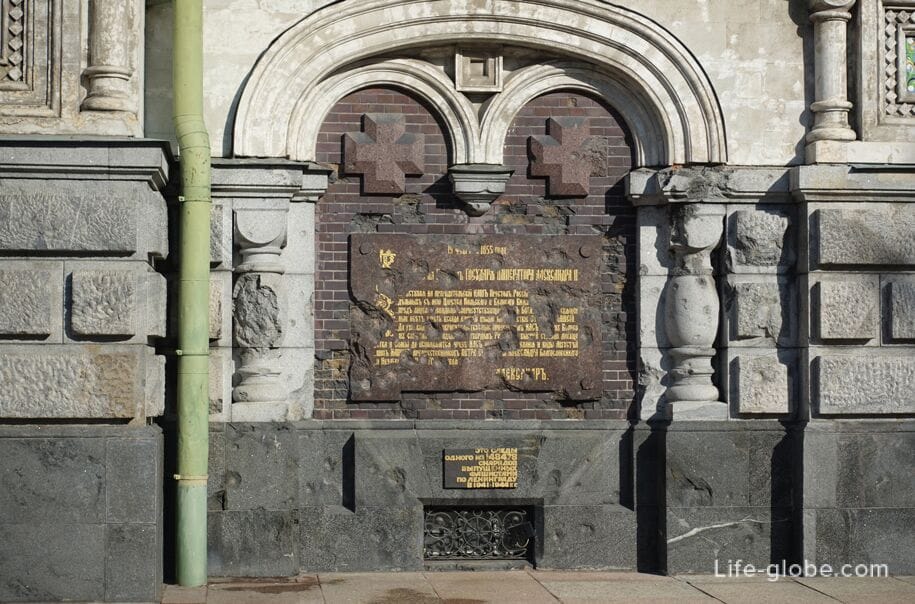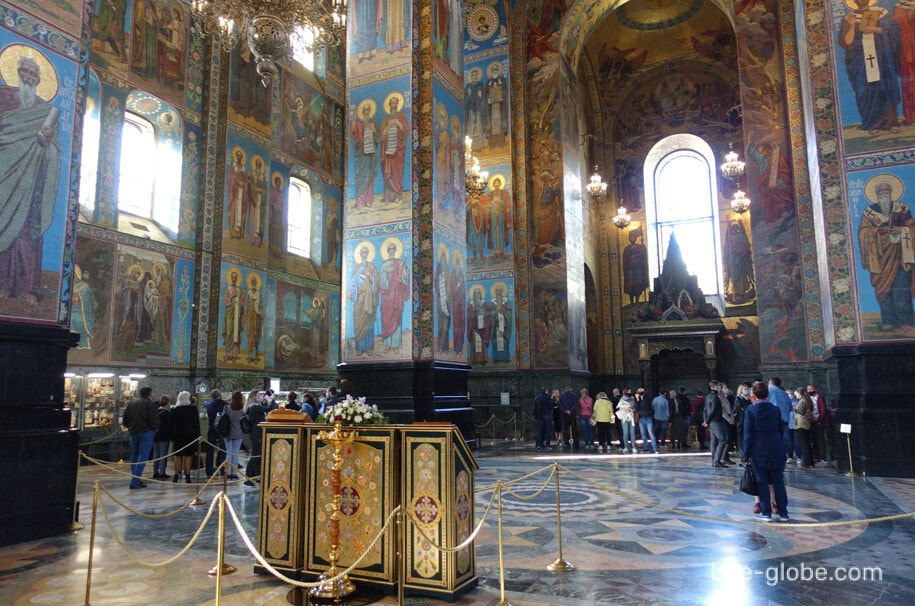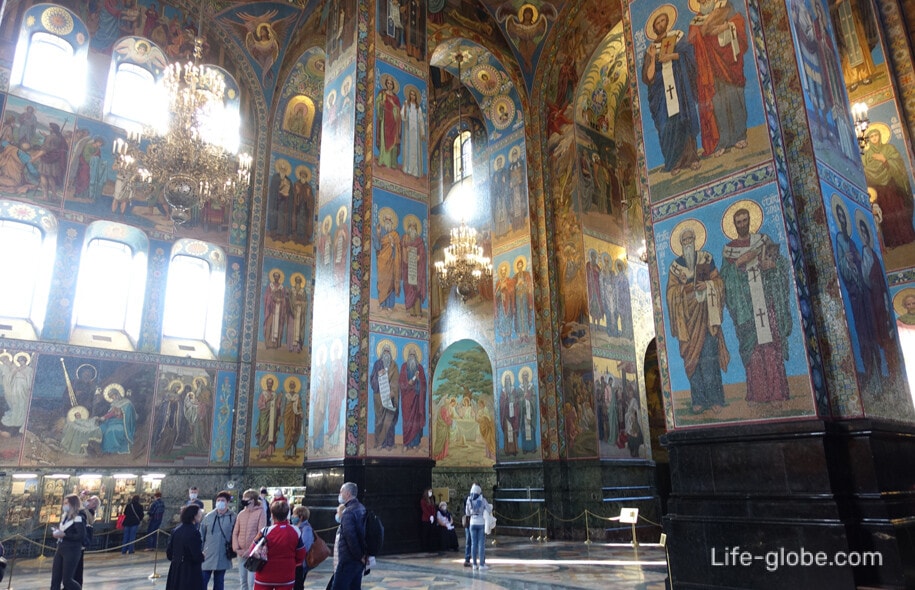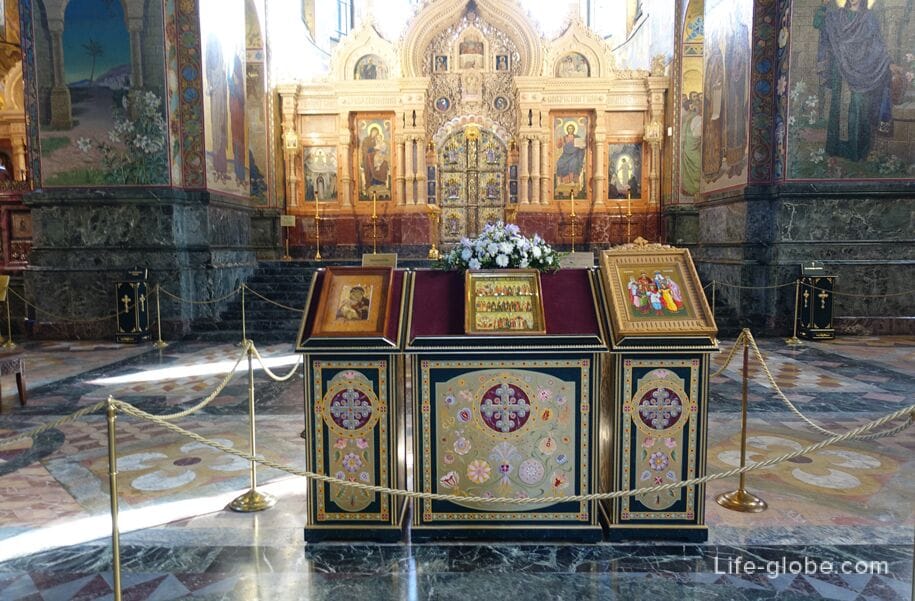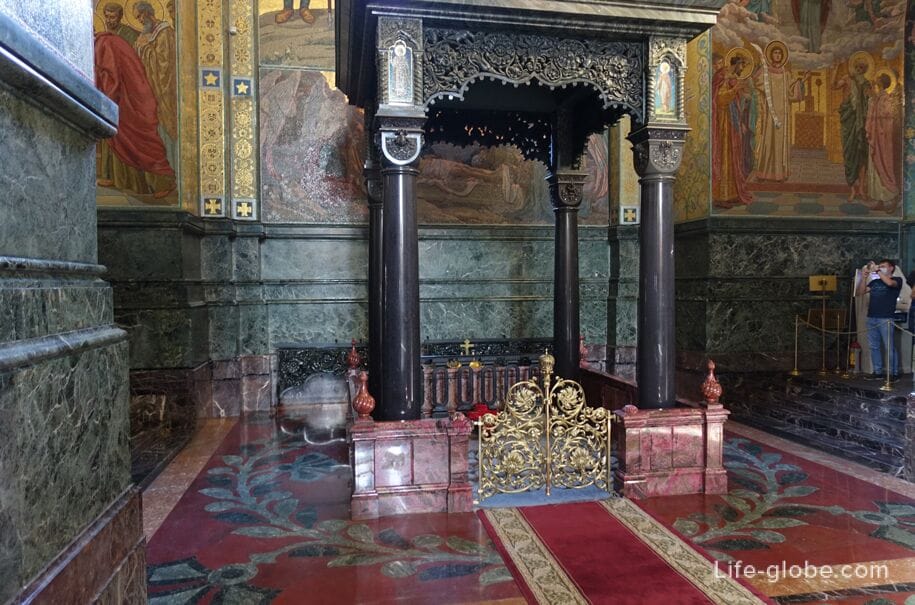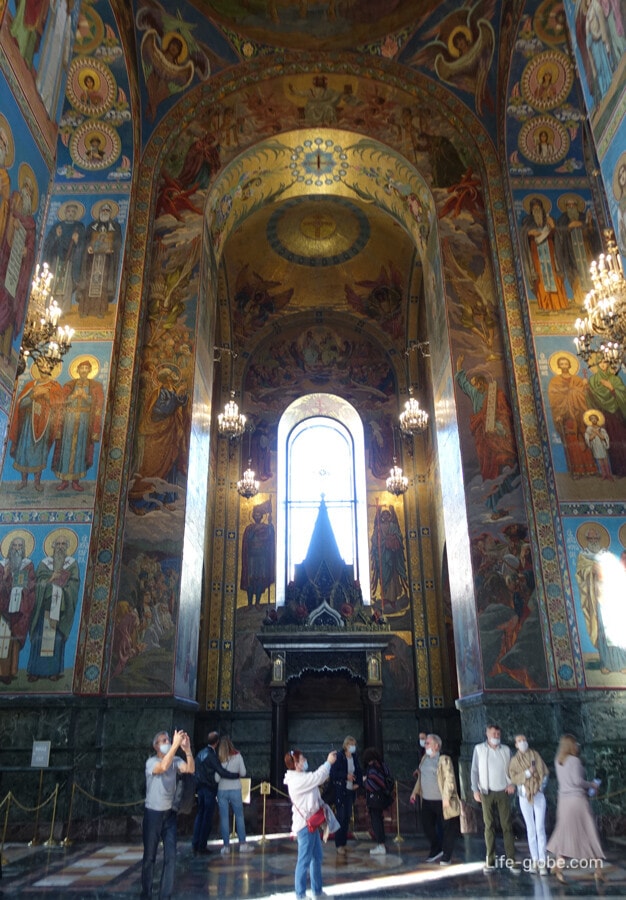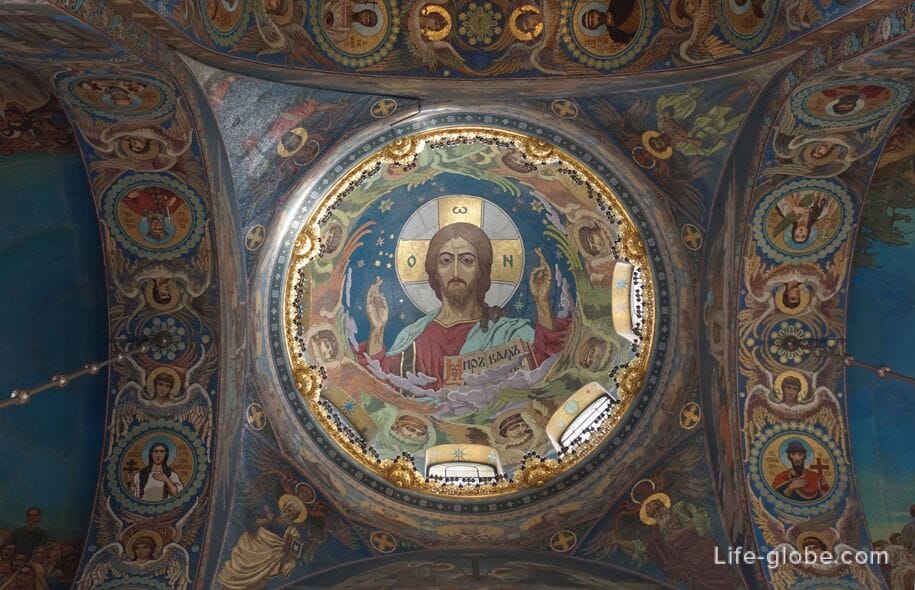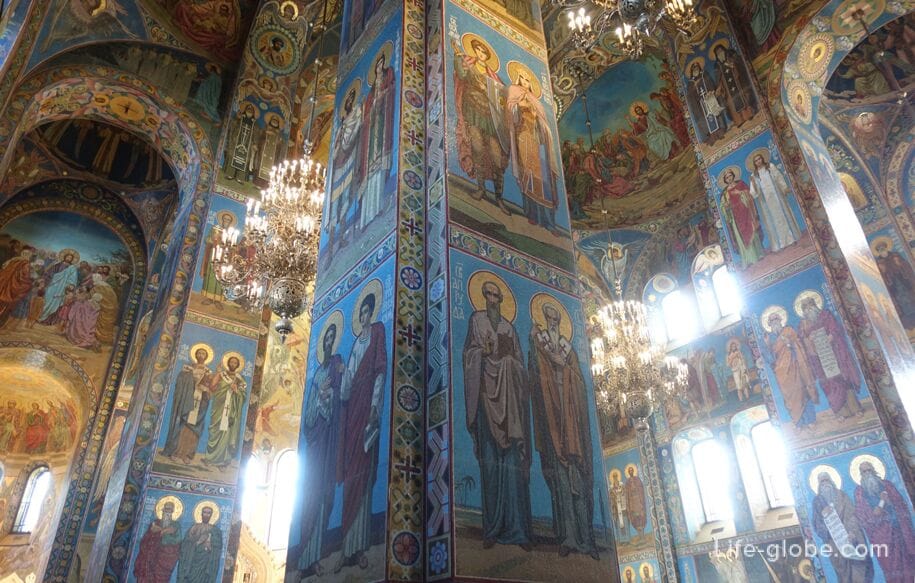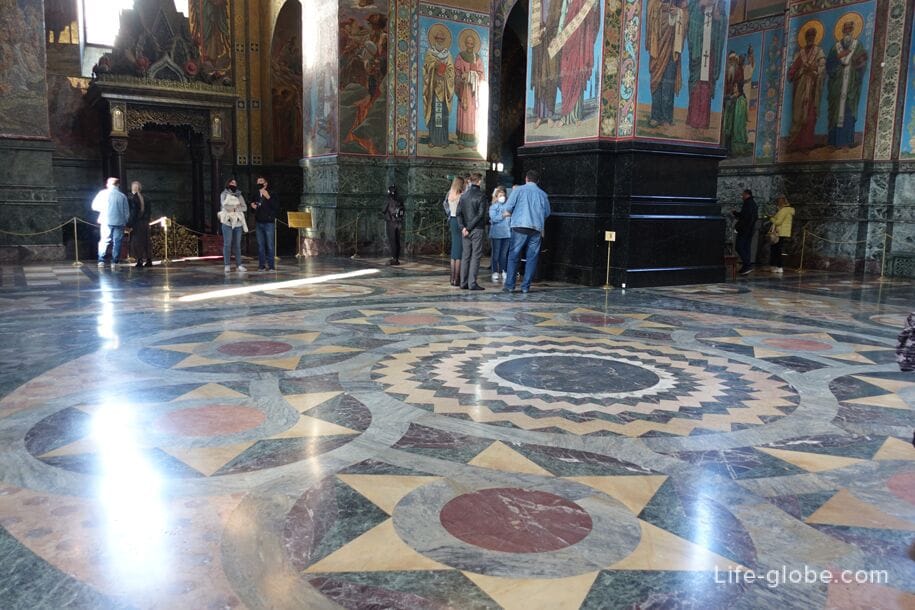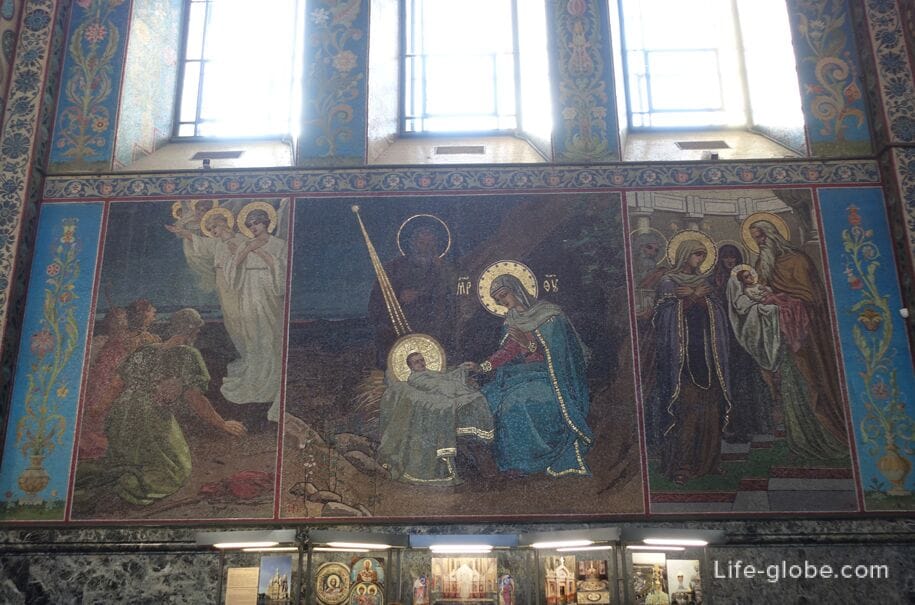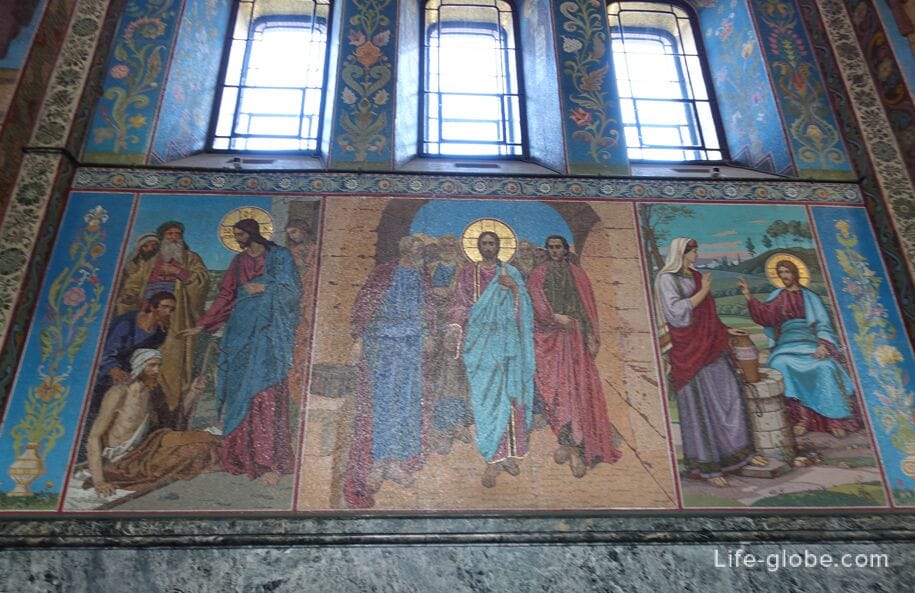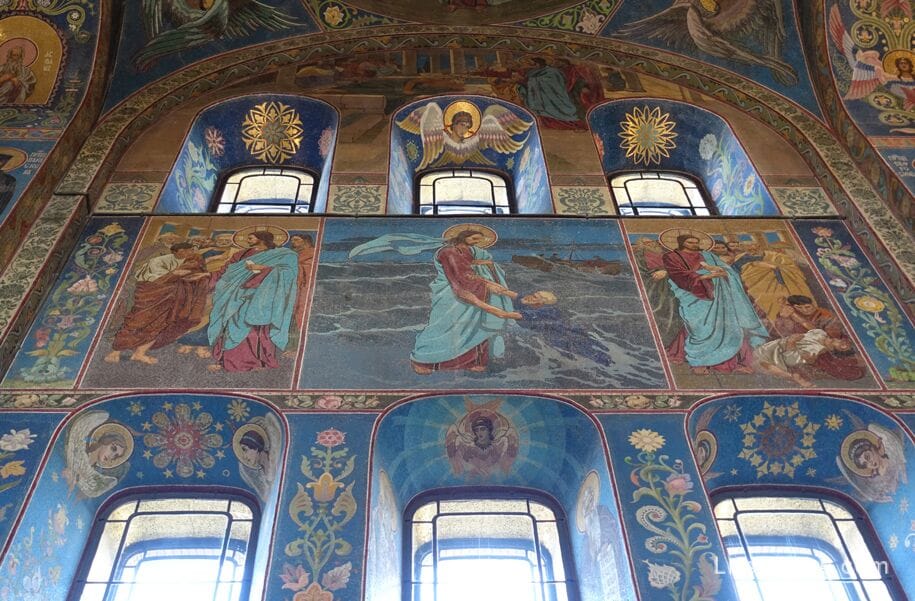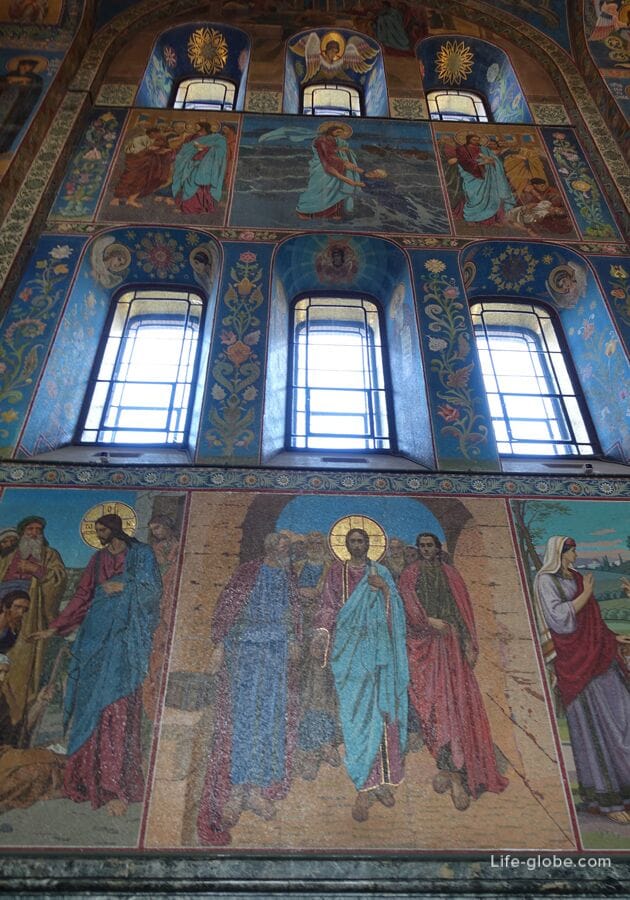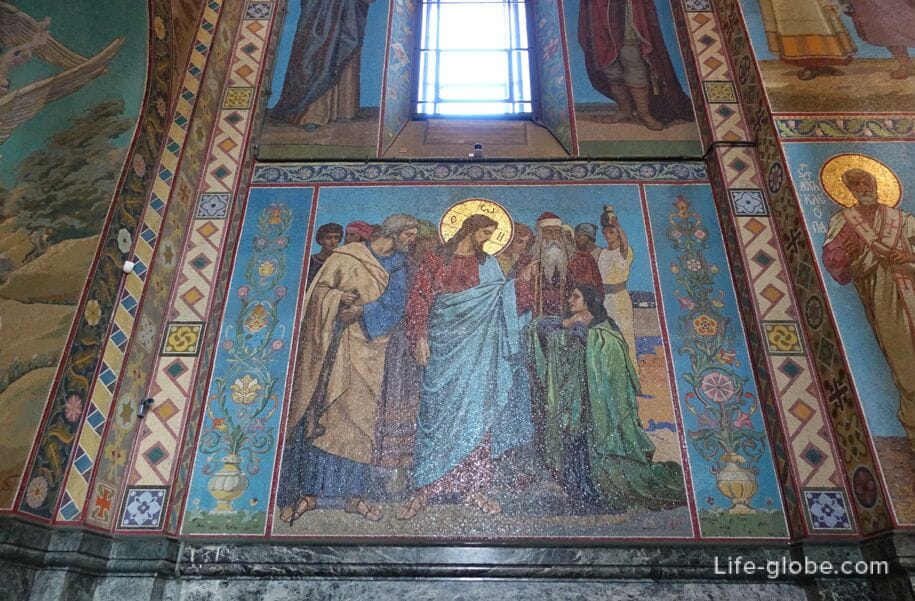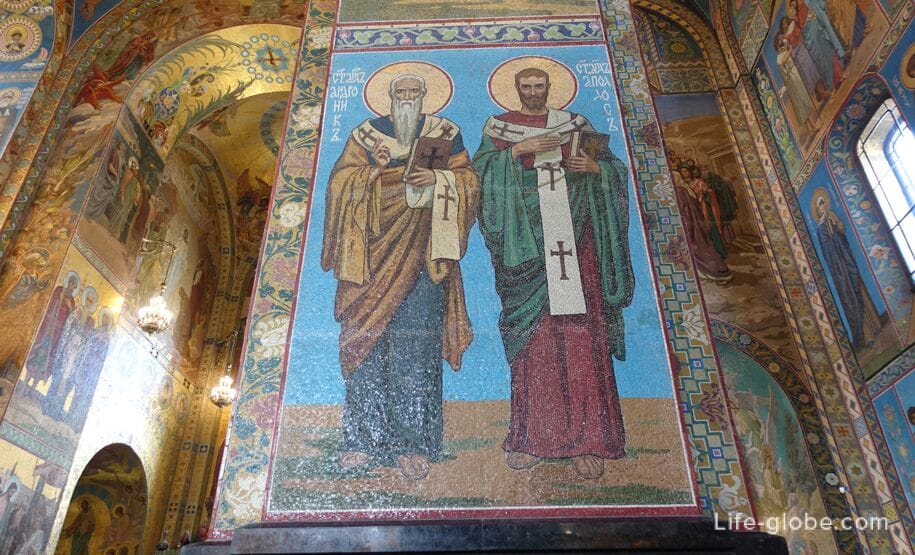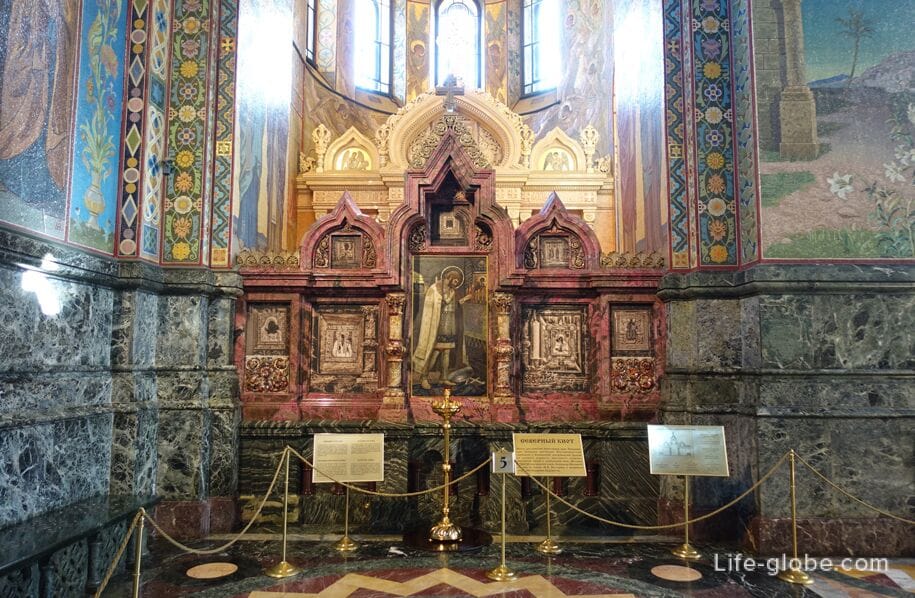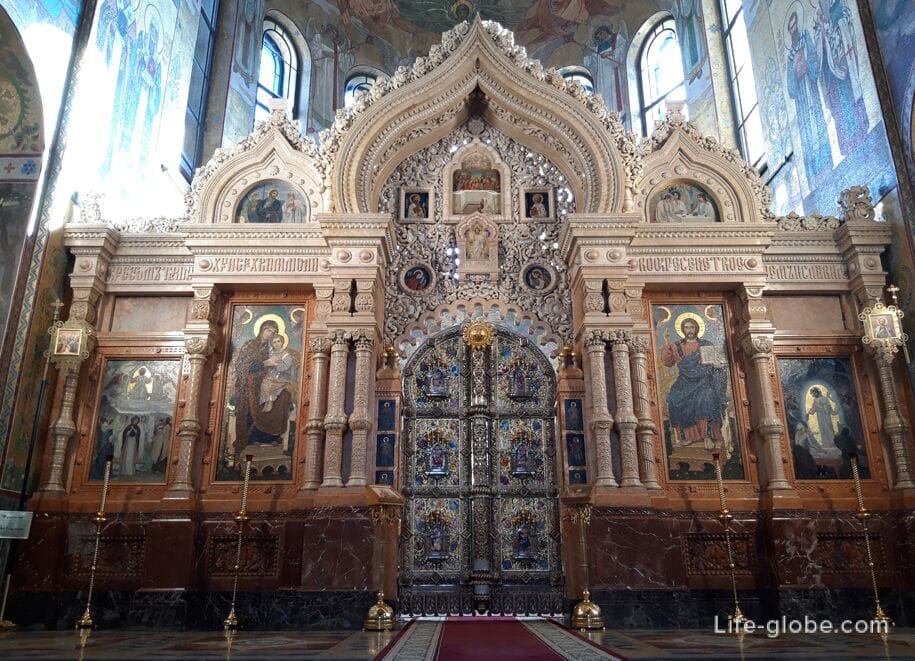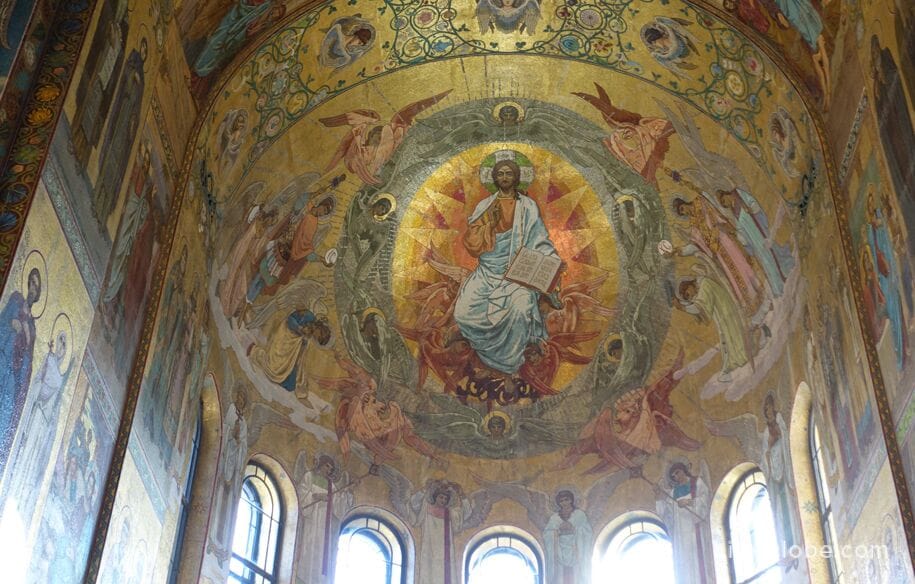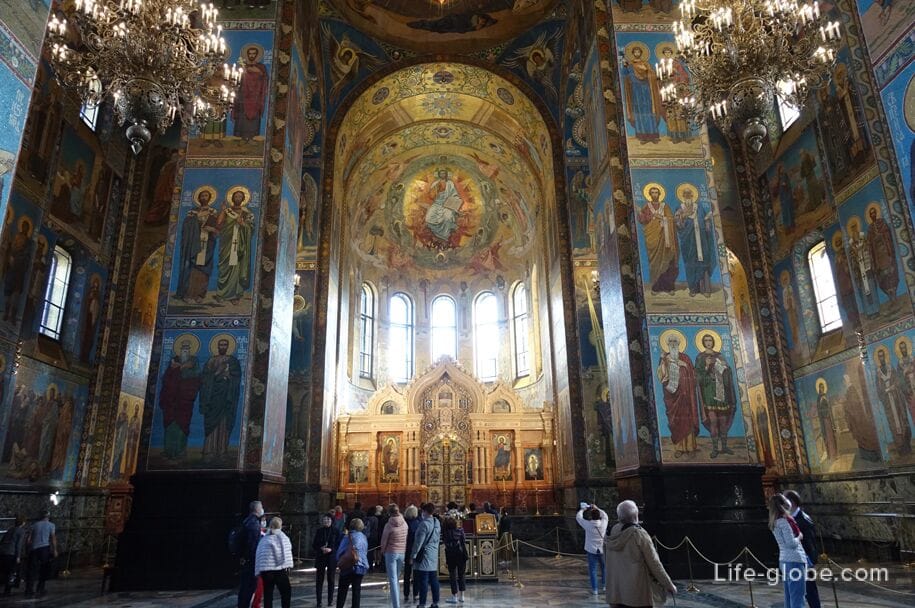Church of the Resurrection of Jesus Christ is known to Petersburgers as the Church of the Savior on the Spilled Blood — or even just the Church on the Blood — as it marks the spot where Alexander II was fatally wounded in an assassination attempt on March 1, 1881. Designed by Alfred Parland in the style of 16th and 17th-century Russian churches, the Church of the Resurrection provides a stark (some would say jarring) contrast to its surroundings of Baroque, Classical and Modernist architecture.
The Cathedral is a unique masterpiece combining the old Russian style of architecture, talent of the best Russian artists and Italian stone carvers, and the art of Roman mosaic. Mosaics cover almost all the surface of the walls and ceilings there are 7 500 square meters of mosaics all in all.
The soviet period history of The Cathedral is nearly as dramatic as the history of its construction. Despite its great artistic and historical value, it was turned into a warehouse after it stopped functioning as an active church in Soviet times. The unique interior was robbed and there were even intentions to blow it up. Luckily this never happened but The Cathedral survived almost by miracle. When eventually the restoration did start, it went on for 27 years (longer than it took to construct The Cathedral). The Cathedral was finally open to public in 1997.
Now you have an opportunity to see the Spilt Blood Cathedral in all its beauty. Do not miss it — it is really worth seeing. We recommend you to take a guided tour during which you will not only observe the magnificent interiors of The Cathedral but also hear its thrilling history in full detail.
Address:
Griboyedov Canal Embankment, 2B, St Petersburg, Russia.
| Persons | 2 | 3 | 4 | 5 | 6 | 7 | 8 | 9 | 10+ |
|---|---|---|---|---|---|---|---|---|---|
| Price per person | 70 € | 50 € | 45 € | 45 € | 45 € | 30 € | 30 € | 30 € | 27 € |
Book Church of the Savior on Blood
The magnificent Church of the Savior on Spilled Blood is one of St. Petersburg’s most memorable landmarks. The church, built at the end of the nineteenth century, is constructed in a classical Russian style decorated with colorful domes and glazed tiles.
Background
Church of the Savior
on Spilled Blood
Officially consecrated as the Church of the Resurrection of Christ, the Russian Orthodox gem more commonly known as the Church of the Savior on Spilled Blood was built to honor tsar Alexander II of Russia, who was assassinated at the site where the church now sits, hence the reference to “spilled blood”. The section of the street on which the assassination took place is enclosed within the walls of the church, and the site of the murder is marked by a chapel in the building.
At the request of Alexander III, son of Alexander II, construction on the church began in 1883. Funding for this amazing structure was almost totally provided by the Imperial family, with other donations made by private individuals. The project was completed in 1907.
The Architecture
The principle architect chosen for the project was Alfred Alexandrovich Parland, who was, incidentally, a non-Russian-born individual. The architecture of the church varies greatly from other buildings and religious structures in St. Petersburg, which were largely constructed in the Baroque and Neoclassical styles. However, the era in which Church of the Savior was built was a time of resurgence of nationalism, thus the classic Russian style of the church.
The domes
Looking at both the interior and exterior, it’s easy to see why the church cost about 4.6 million rubles, way over the budgeted 3.6 million. The outside was designed to mirror the magnificent St. Basil’s in Moscow, the city’s easily-recognizable centerpiece, and the building – both inside and outside – features about 7,000 square meters of mosaics, most of them designed by the prominent artists of the time, including Viktor Vasnetsov, Mikhail Nesterov and Mikhail Vrubel. The majority of the mosaics depict biblical scenes and saints, though some are just patterns. The colorful onion domes, of which the central one reaches a height of 81 meters (266 ft), are covered with bright enamels.
The Church after the Revolution
The church along the
Griboedova canal
During the Russian Revolution of 1917, much of this amazing church was ransacked, and the interior was seriously damaged. In the 1930s, the Soviets closed the church, as they did with most churches in St. Petersburg. During World War II, it was used as a storage facility for food. If suffered yet more damage during the war, and afterward, was used for many years as storage space for a local opera company.
In 1970, St. Isaac’s Cathedral assumed management of the church, and funds garnered from the cathedral (which was, at that time, a museum) were used to restore the Church of the Savior. Restoration was finally complete in 1997 and remains one of St. Petersburg’s top tourist attractions.
- Next: St. Isaac’s Cathedral

The church is particularly popular among foreign tourists. Artists, live music, souvenirs sellers are usually working next to the cathedral.
Why this church is so popular with tourists? There are several reasons for this.
- Exterior of the cathedral combines images of many Russian Orthodox churches. Bright, richly decorated building has features of many Russian churches. Great influence on the appearance of the temple had architecture of St. Basil’s Cathedral in Moscow.
- The interior of the cathedral is unique. All walls, pylons, arches and domes are covered with mosaic. A rich collection of gems, jewelry enamel, colored tiles, made by best artists of that time was used in finishing the building. Inside the temple is a veritable collection of mosaics. The church mosaic collection is one of the largest collections in Europe.
- Cathedral of the Savior on Blood is located in the heart of the city near the metro station “Nevsky Prospekt”. Walking from Nevsky Prospect on the embankment of Griboyedov Canal is the most convenient way to get to it.
Brief history of the cathedral
Church of the Savior on Spilled Blood (Church on Spilt Blood or Cathedral of the Resurrection of Christ ) in Saint Petersburg was built on the place where was attempt to kill Emperor Alexander I. Church is located in the historic center of St. Petersburg on the “Griboyedov” canal embankment. The height of the temple is 81 m.
Construction of the temple began in October 1883. The cathedral was consecrated August 6, 1907. It was decided to destroy the church in November 1931, but this decision was not implemented. The cathedral housed a mortuary during the Second World War. There was a warehouse after the war in the temple. The cathedral was get under state protection in 1968.
The museum “Church on Spilt Blood“ was opened for visitors August 19, 1997. The Cathedral is a branch of the «St. Isaac’s Cathedral» museum. Entrance to the Cathedral is for an extra charge. (Full ticket cost 250 rubles, 2016.)
There are located close to this place: the Russian Museum, the Mikhailovsky Theatre, Mikhailovsky Castle, Summer Garden, the Field of Mars, Nevsky Prospect.
- Address: St. Petersburg, Griboedov emb., 2.
- The nearest metro stations: “Nevsky Prospekt”, Gostiny Dvor.
- You can check the cathedral location on the Saint Petersburg map.
1) Установите соответствие между заголовками 1 — 8 и текстами A — G. Используйте каждую цифру только один раз. В задании один заголовок лишний.
1. See a snake crawling down
2. Natural wonder
3. Created to protect
4. Mysterious rocks
5. Lost city
6. The really cool place
7. Go there now
8. Ancient sculptures
A. Eight thousand feet above sea level, this five-century-old pre-Columbian site was once home to the Incas. Until American historian Hiram Bingham publicized his findings of the area in a book called “Across South America,” the mountain-top ruins were widely unknown to anyone living outside of the Urubamba Valley. Since Spanish colonialists had no idea of Machu Picchu’s existence, Incan architecture and design of the buildings were preserved.
B. Does the arrangement of the 25-ton sandstone blocks at Stonehenge suggest some sort of spiritual prediction? No one really knows. Theories about the nearly 5,000-year-old circular stone structure vary. The most intriguing time to visit Stonehenge is at sunset when a yellow-orange glow can be seen through the magnificent towers’ arches making some people believe that it was originally a place of healing, while others think it was used for ancestor worship.
C. The 1,500-year-old pyramids, located near the town of Merida, may be less popular than their equivalents in Egypt, but they are just as remarkable. Although there are many structures there like the Temple of the Warriors or the Wall of Skulls, the main attraction is El Castillo, the 78-foot, 91-step central pyramid. The absolute best time to travel to El Castillo is at sunset when shadows give the illusion that a large serpent is sliding down the pyramid.
D. The Earth’s southernmost point, Antarctica, is the driest and coldest of the seven continents. For a place that is 98 per cent covered in one-mile-deep ice, it is hard to imagine why anyone would want to visit it at all. But there is a strange beauty about Antarctica that is incomparable to anywhere else on the planet. Anyway, while Antarctica has no permanent residents, there are often up to 5,000 researchers working there at a time.
E. It is believed that hundreds of years ago the natives of Easter Island carved massive heads out of stone to honor their ancestors. Today, there are 887 “moai,” as the statues are called, which create a mysterious, yet intriguing landscape on this Polynesian island, which is a four-and-a-half hour flight from Lima, Peru. The tallest statue on the island, named Paro, is 33 feet high and weighs 82 tons.
F. North America’s Red Canyon is 277 river miles long, eighteen miles wide, and one mile deep, and if it doesn’t make your mouth drop with surprise, then you might not be human! Most tourists go there by car and there are plenty of spots along the way to pull the car over and have a look from the top. You can also go down into the canyon’s depths and experience the very heart of the canyon by going rafting on the Colorado River, and even spend the night at a hotel below the rim.
G. Thousands of miles long, the Great Wall of China is the largest cultural object humans have ever built. It majestically snakes through China, winds around rising and falling hills, twists through an enormous countryside, and stretches from Shanhaiguan in the east to Lop Lake in the west. However, the wall was constructed more than 2,000 years ago not to amaze people, but in an attempt to keep out invading tribes from the north.
| A | B | C | D | E | F | G |
2) Прочитайте текст и заполните пропуски A — F частями предложений, обозначенными цифрами 1 — 7. Одна из частей в списке 1—7 лишняя.
Finding your sportsman spirit
Doing sports, we can really test our physical fitness in contest, and it is one of the only ways that nations clash peacefully. Sportsmen and sportswomen are today’s warriors — the contests ___ (A) on the pitches and courts are the closest things we have to gladiatorial fighting.
If sportsmen are like warriors, then the ‘sportsman spirit’ could be considered the closest thing we have to a warrior’s code — to bushido or to chivalry. If you develop good sportsmanship then this means that you take joy in the contest and at the same time ___ (B), that you win graciously and that you don’t cheat.
If you have put time and effort into training then you are aware of the blood, sweat and tears that the opposition has put in as well. They will have had the same dedication to their game as you have and you will know precisely ___ (C) . In this way you are brothers (or sisters) and the only difference between you is ___ (D) different teams. For this reason they deserve your respect.
There are many traditions in many sports to help us retain good relationships with our opponents. This means things like shaking hands at the end of a tennis match, and this is ___ (E) and honourable rather than just being muddy skirmishes.
You might have performed brilliantly on the pitch, but you are kidding yourself if you believe ___ (F) of your own doing. If nothing else, the weather and luck will have played a role in the outcome, and if you’re playing a team sport then you are only one cog in a machine.
1. what keeps sports civil
2. who can’t keep their temper
3. that you chose
4. that you respect your opponent
5. that your victory was entirely
6. that are played out
7. what they have been through
| A | B | C | D | E | F |
3) Прочитайте текст и запишите в поле ответа цифру 1, 2, 3 или 4, соответствующую выбранному Вами варианту ответа.
Показать текст. ⇓
According to the text, the most distinctive characteristic of the brain is its
1) ability to control the body.
2) elaborateness.
3) size.
4) weight.
4) Прочитайте текст и запишите в поле ответа цифру 1, 2, 3 или 4, соответствующую выбранному Вами варианту ответа.
Показать текст. ⇓
The claims that the brain is better than any computer because it
1) processes more information.
2) works faster.
3) can download information from different sources.
4) reacts to information more adequately.
5) Прочитайте текст и запишите в поле ответа цифру 1, 2, 3 или 4, соответствующую выбранному Вами варианту ответа.
Показать текст. ⇓
According to the text, the work of brain neurons influences
1) electricity production.
2) our dreams.
3) everything we do.
4) character of messages we send.
6) Прочитайте текст и запишите в поле ответа цифру 1, 2, 3 или 4, соответствующую выбранному Вами варианту ответа.
Показать текст. ⇓
The narrator compares the work of neurons to a pinball machine to
1) show the character of brain work.
2) raise the awareness of the brain’s nature.
3) stress the amount of information that the brain processes.
4) illustrate the shape of the neuron highways.
7) Прочитайте текст и запишите в поле ответа цифру 1, 2, 3 или 4, соответствующую выбранному Вами варианту ответа.
Показать текст. ⇓
Comparing sensory and motor neurons, we can make a conclusion that
1) motor neurons transmit information faster.
2) there are more motor neurons.
3) sensory neurons transmit information faster.
4) there are more sensory neurons.

Показать текст. ⇓
The structure of brain changes when
1) our memory fails.
2) new neurons appear.
3) we are riding a bike.
4) we acquire new knowledge.
9) Прочитайте текст и запишите в поле ответа цифру 1, 2, 3 или 4, соответствующую выбранному Вами варианту ответа.
Показать текст. ⇓
Physical exercises proved to be good for
1) the production of brain chemicals.
2) solving homework problems.
3) giving the brain a rest.
4) maintaining a good mood.
Спас на Крови или храм Воскресения Христова — один из самых красивых и величественных храмов России, расположенный в центре Санкт-Петербурга на набережной канала Грибоедова.
Полное название храма — собор во имя Воскресения Христова на Крови, который в народе называют Спас-на-Крови.
Храм является одновременно православным храмом, мемориальным памятником и музеем русской архитектуры конца 19 начала 20 веков.
Спас на Крови был воздвигнут в память о том, что на этом месте (ныне набережная канала Грибоедова, ранее — Екатерининский канал) днем 1 (13 по новому стилю) марта 1881 года в результате покушения (взрывы двух бомб) был смертельно ранен император Александр II. Раненого царя уложили на сани и отвезли в Зимний дворец, где он скончался через полтора часа.
Таким образом, собор является мемориалом Царю-Освободителю, а выражение «на Крови» отражает историческое событие и указывает на трагедию и пролитую кровь царя.
Место смертельного ранения императора сразу же приобрело особое, сакральное значение. Уже вечером 1 марта участок был огорожен деревянным забором, рядом с которым выставили часового.
На месте покушения была возведена временная небольшая часовня.
Преемник Александра II — его сын Александр III, по инициативе городской думы, решил увековечить память погибшего царя и возвести на месте цареубийства храм-памятник, который должен был быть создан по мотивам московского и ярославского зодчества конца 16-17 веков и так, чтобы памятное место — место смертельного ранения царя на набережной, находилось внутри собора.
Как и ранее, сегодня храм Спас на Крови подступает непосредственно к каналу Грибоедова и захватывает часть набережной. Что делает его ещё более претягательным и неразрывным единым целым с каналом.
Возведение храма проходило с 6 октября 1883 по 1907 годы по проекту архитектора Альфреда Александровича Парланда в соавторстве с настоятелем Троице-Сергиевой пустыни архимандритом Игнатием (Малышевым), который и предложил назвать храм «Воскресения Христова». Архитектор собора, творчески переработав приемы русского церковного зодчества московских церквей 17 века, получил так называемый стиль «Русской эклектики».
Перед началом строительством храма часть чугунной решетки набережной канала, за которую держался раненый царь, гранитные плиты и часть булыжной мостовой, обагренные кровью Александра II, были сняты, уложены в ящики и перенесены на хранение как реликвии в часовню на Конюшенной площади.
Строительство храма осуществлялось: частично за счет царской семьи, частично за счет народных пожертвований, а большая часть средств была выделена главным казначейством.
При строительстве были применены все передовые достижения науки и техники того времени: была выполнена система молниезащиты, громоотводами служили кресты центральной главы и колокольни; в помещении была устроена оригинальная система воздушного отопления, разработанная в бюро инженера С.Я. Тимоховича; освещение храма было электрическим.
Собор был освящен 19 августа (1 сентября по новому стилю) 1907 года митрополитом Санкт-Петербургским и Ладожским Антонием в присутствии императорской четы, великих князей и княжон, министров Двора и высшего духовенства.
Изначально храм не был рассчитан на массовое посещение. В неё не крестили, не венчали и не отпевали. В храме проходили только службы и панихиды, посвященные памяти императора Александра II.
Храм находился на содержании у государства.
После революции храм на некоторое время стал кафедральным. В 1930 году был закрыт и ставился вопрос о его сносе. Но эти планы не состоялись. В здании размещались разного рода склады (овощные, мастерские).
Во время войны (блокады Ленинграда) собор был поврежден, но не разрушен. Также в соборе размещали морг. После войны храм был отдан Малому оперному театру, который устроил в стенах храма склад декораций.
В советское время многие ценности собора были утрачены (разграблены, уничтожены).
В 1968 году собор был взят под охрану Государственной инспекцией по охране памятников при Главном архитектурно-планировочном управлении. После собор начали восстанавливать.
Сегодня Спас на Крови имеет статус музея (для всех желающих проводят небольшие экскурсии по собору), также в соборе проходят службы.
Девятиглавый храм выделяется русским зодчеством с многоцветным обликом, наружными мозаичными композициями, мраморными украшениями и обилием архитектурных элементов.
Наружный цоколь храма облицован темно- и светло-серым валаамским гранитом, привезенным с острова в Ладожском озере.
Прогуливаясь по центру Петербурга довольно сложно не заметить этот храм, поскольку его живописная композиция «русской эклектики» ярко выделяется в классицистической среде близлежащих строений и в тоже время очень гармонично вписывается в облик города, украшая собой набережную.
В западной части Спаса на крови (возле канала Грибоедова), над местом смертельного ранения Александра II, находится колокольня.
Всю нижнюю часть колокольни занимают мозаичные гербы губерний, областей и городов русских, жители которых участвовали в создании храма.
Под золоченым навесом находится рельефный мраморный крест с мозаичным распятием Спасителя — аллегория жертвенного подвига царя-мученика.
В восточной части собора (обращенной к Михайловскому саду) три полукруглые апсиды увенчаны небольшими золочеными главками.
На южной внешней стене собора (в нижней части), можно видеть следы от пуль и осколков снарядов, попадавших в собор во время войны.
Данный кусок стены специально не был реставрирован, его оставили как память о войне, чтобы каждый мог видеть губительную силу людских войн и не повторять страшных ошибок человечества.
Интерьер Спаса на Крови
Интерьер Спаса на Крови богато декорирован русским поделочным камнем и итальянскими мраморами, а мозаичный ансамбль, являющийся доминантой пространства интерьера, был создан по проектам художников рубежа 19-20 веков и считается одним из крупнейших собраний монументальной мозаики в Европе.
Мозаичные композиции в соборе разделяют различные орнаменты, которых в храме около 80-ти.
Общая режиссура мозаичного ансамбля собора принадлежит архитектору Парланду.
Особое значение в интерьере храма занимает западная его часть (сторона возле канала Грибоедова), которая представляет собой мемориальный комплекс и включает место смертельного ранения Александра II на набережной.
Место ранения царя в храме представлено каменной шатровой сенью. Сень в данном случае — это художественно оформленный навес на колоннах, символизирующий собой покров или защиту данного места.
Под сенью сохранены, обагренные кровью царя, часть мостовой, которая была уложена после возведения храма, и звено чугунной решетки набережной канала на которую опирался раненный царь.
Рисунок сени был сделан архитектором А. Парландом по образу царского места — Маномахова трона Ивана Грозного в Успенском соборе Московского кремля.
Для создания сени использовали лучшие образцы отечественных поделочных камней — родонита и различных видов яшмы.
До наших дней дошли только 4 яшмовые колонны и часть балюстрады из родонита. Верхняя часть — это макет, который сделан из гипса и тонирован под натуральный камень.
Западная (мемориальная) часть собора декорирована мозаиками, рассказывающими об учениях, распятии и воскресение Иисуса Христа. Здесь проводится своеобразная параллель между трагической насильственной смертью императора Александра II и смертью Иисуса Христа.
Здание храма вытянуто по оси восток-запад на 60 метров. Общая площадь зала храма составляет 886 квадратных метров. Основой конструкции являются 8 столбов (пилонов), которые делят внутреннее пространство храма на три нефа (три продольные части).
Центральный неф более широкий и в пересечении с поперечным сечением в плане образует крест, над центром которого возвышается купол.
В плафоне центрального купола в мозаике изображен Христос Пантократор или Вседержитель на фоне синего неба усыпанного звездами, его руки подняты в благословляющем жесте, а на груди открытый евангелие с приветственной фразой «Мир Вам».
Мозаика находится на высоте 45 метров и создана по проекту художника-иконописца Николая Харламова.
Всё пространство храма символически делится на две зоны — небесную и земную.
К небесной относятся — алтарные апсиды, в восточной части купол и своды, а к земной — стены и пилоны.
Стены, пилоны и своды полностью отделаны мозаикой из смальты — небольшие кубики непрозрачного цветного стекла. Общая площадь мозаичного ансамбля фасада и интерьера храма составляет 7 000 квадратных метров.
Каменная мозаика украшает и пол храма.
Мозаики, рассказывающие о земной жизни Иисуса Христа, сплошным ковром покрывают южную и северную стены храма. Все композиции на стенах храма, из жизни Христа, объединяются в единый рассказ о священном писании.
Такая система оформления храмов позволяет наиболее полно раскрыть суть христианского учения в ярких зрительных образах. Система заимствована из византийского церковного искусства.
На предалтарных пилонах размещены сцены Благовещения. Мария получает весть о том, что она родит ребенка — сына всевышнего Бога.
Повествование продолжается на южной стене. Здесь присутствуют композиции: Рождество христово, явление ангелов людям, крещение Христа.
В 30 лет Христос крестился и начинается земное служение Иисуса Христа, о котором повествуют композиции на северной стены храма. Здесь изображены чудеса исцеления, и успокоение бури, о которой рассказывает мозаика «Хождение по водам», созданная по проекту художника Андрея Рябушкина.
Мозаики в храме выполнены учениками школы братьев Фроловых.
Братья Фроловы освоили венецианский или обратный способ набора мозаики из смальты. Обратный способ набора мозаики был в пять раз быстрее и, соответственно, в пять раз дешевле обычного прямого способа набора.
Художник создавал упрощенный живописный оригинал с четко проработанным контуром, с которого снималась калька в зеркальном отражении. Мастер наклеивал на полотняную кальку кусочки смальты, не видя лицевой стороны. Набранная мозаика заключалась в деревянную раму и заливалась цементом с железной арматурой. После высыхания кальку смывали, а мозаичные блоки размером метр на полтора, на железных штырях крепили на стену. Швы фрагментов закладывали смальтой уже прямым способом набора, вследствие чего на мозаиках в соборе можно видеть белесые горизонтальные полосы, которые отмечают границы мозаичных блоков.
Южный и северный киоты в храме — своеобразные витрины для демонстрации икон, которые закрывают часть иконостаса.
Каждый киот был рассчитан на 8 икон. В центре находилась мозаичная икона, остальные семь были традиционными.
Киоты были местом для наиболее почитаемых икон. Иконы в советское время были сняты и утрачены, и сейчас на их месте находятся черно-белые фотографии. Сохранились только две мозаичные иконы, по одной в южном и северном киотах.
Киоты выполнены мастерами Екатеринбургской гранильной и Колыванской шлифовальной фабрик из розового родонита, коргонского порфира, ревневской, орской и аушкульской яшм.
Подбор камня для киотов был не случайным, он носил мемориальный характер. Из ревневской яшмы (зеленый цвет) был сделан саркофаг для императора Александра II. А из родинита (розовый цвет) — саркофаг для жены императора — Марии Александровны. Оба саркофага сейчас можно видеть в Петропавловском соборе (Петропавловской крепости), который находится на Заячьем острове в Санкт-Петербурге.
Центральная мозаичная икона северного киота носит название «Святой благоверный князь Александр Невский» и на ней изображен Александр Невский, который считался небесным покровителем Александра II.
Мозаика набрана по эскизу М.Н. Нестерова в мозаичном отделении Академии Художеств прямым способом набора из смальты, в каждом кусочке которой соединены несколько цветовых оттенков. Благодаря этому данная мозаика отличается от настенных и имеет более глубокие цветовые гаммы и её можно причислить к стилю модерн, который входит в моду в начале 20 века в России.
Центральная мозаичная икона южного киота «Воскресение Христа». Иисус Христос стоит у отваленного от пещеры камня, а сверху надпись — «Где ты смерти жало…». Икона создана Михаилом Нестеровым.
Иконостас храма Спаса на Крови, расположенный в центре между киотами, является преградой, отделяющей алтарь от центральной части храма.
Иконостас исполнен в Генуе фирмой «Нови» из разноцветных итальянских мраморов. В нижней части коричневый, в средней — розовый и в верхней — светло-желтый мрамор.
Невысокий трехчастный иконостас как в древнерусских церквях, был выполнен по проекту Парланда.
В центре иконостаса — Царские врата. Исторические царские врата были утрачены, затем воссозданы реставраторами и вновь установлены в 2012 году.
Главные образы иконостаса — образ Иисуса Христа в облике императора сидящим на троне, и Богородицы, которая нежно склонилась над маленьким Иисусом.
С правой стороны от иконы Иисуса Христа изображена икона «Сошествие в ад» — в византийской традиции так изображается Воскресение Иисуса Христа. Во втором веке нашей эры становится известно апокрифическое евангелие от Никодима, в котором рассказывается о том, как Иисус Христос спускается в ад за своими прародителями Адамом и Евой. В иконе изображен темный мрак бездны, в центре Иисус Христос, окруженный голубоватым ореолом. Иисус протягивает руки к коленопреклоненным Адаму и Еве. В этом сюжете заложен глубокий смысл — воскресение Христа дает надежду на воскресение всего рода человеческого.
Крайняя левая икона — «Вознесение» — на 40 день Иисус Христов вознесся на небо. Внизу на земле изображена стоящая Богородица, рядом с ней два ангела, а сверху — в небо возносится Иисус Христос.
Над иконами «Сошествие в ад» и «Вознесение» работал Михаил Нестеров.
На сводах центральной апсиды находится мозаика «Спас во Славе», над проектом которой работал художник Николай Харламов.
Христос представлен в сиянии божественного света. Голубоватый овал означает вселенную. В центре вселенной на престолах восседает Христос. Его окружает небесное воинство.
Вдоль нижних частей стен храма тянутся каменные скамьи, которые являлись частью вентиляционно-отопительной системы.
В подвале находились два котла и восемь калориферов. Теплый воздух проходил через ажурные решетки скамеек и таким образом осуществлялся обогрев храма.
Практическая информация
Храм Воскресения Христова (Спас на крови) является мемориалом и музеем, входящим в государственный музей-памятник «Исаакиевский собор».
Также в храме проводят службы.
Посещение собора возможно за плату. Билеты можно приобрести в кассах, расположенных возле собора или купить заранее — на официальном сайте музея.
В соборе проводят экскурсии, которые длятся около 30 минут.
Посетить собор можно бесплатно во время проведения служб.
Часы работы собора, время проведения служб и стоимость билетов рекомендуем уточнять непосредственно перед посещением.
Сайт музея: cathedral.ru.
Сайт собора Воскресения Христова: spas.spb.
Адрес собора Воскресения Христова: набережная канала Грибоедова, 2Б.
Собор Воскресения Христова можно также посетить с экскурсией
Рядом со Спасом на Крови, по адресу: набережная канала Грибоедова 2А литер Л, находится часовня во имя Иверской иконы Божией Матери, которая совместно с храмом составляет единый архитектурный ансамбль и в которой ныне расположен музей.
Помимо этого, в состав государственного музея-памятника «Исаакиевский собор», также входят: сам Исаакиевский собор и колоннада Исаакиевского собора — смотровая площадка.
Все средства размещения в Санкт-Петербурге, в том числе в центре города и вблизи Спаса на Крови, можно посмотреть и забронировать здесь
[booking blog_id=140]
Скачать материал

Скачать материал


- Сейчас обучается 110 человек из 38 регионов




Описание презентации по отдельным слайдам:
-
1 слайд
Saint Petersburg. Sights and Attractions.
-
2 слайд
Тhe cultural capital of Russia
St. Petersburg is often called the cultural capital of Russia because the city is famous for its museums, palaces, monuments and theatres.
The Alexandrinski Drama Theatre, the Bolshoi Drama Theatre, the Mariinsky Theatre of Opera and Ballet are pearls of Russian art. -
3 слайд
Aurora
A former Russian naval ship that has played an important part in the country’s history, the cruiser Aurora is now a The cruiser Aurora was built between 1897 and 1900 at the Admiralty Shipyard in St. Petersburg. It was one of three Pallada-class cruisers, all of which served during the Russo-Japanese War. museum in St. Petersburg. -
4 слайд
Saint Petersburg was founded in 1703 by Tsar Peter the Great
Saint Petersburg was founded in 1703 by Tsar Peter the Great. During the following two centuries, when Saint Petersburg was the capital of Russia, the city quickly developed into one of the world’s most magnificent cities thanks to the construction of impressive edifices such as the Winter Palace, the Admiralty ,the MariinskyTheater and St. Isaac’s Cathedral -
5 слайд
The State Hermitage Museum
The State Hermitage Museum is one of the largest and oldest museums in the world and an absolute must-see for any visitor to St. Petersburg. The museum was founded in 1764 by Catherine the Great, empress of Russia, and opened to the public in 1852. -
6 слайд
The Russian Museum
St. Petersburg’s Russian Museum was established in the late nineteenth century by Emperor Nicholas II as the first state museum of Russian fine art. Most of its vast collection is displayed in the Mikhailovsky Palace.
-
7 слайд
Peterhof
Peterhof was built in the early eighteenth century by tsar Peter the Great as a magnificent palace and park complex meant to rival France’s Versailles. On an estate that covers more than six hundred hectares, Peter and his successors built some thirty palaces and pavilions in a mesmerizing display of wealth and power. -
8 слайд
Bronze Horseman
The equestrian statue of Peter the Great, known as the Bronze Horseman, is a tribute to the founder of St. Petersburg. The fascinating monument is one of the most famous symbols of the city.
-
9 слайд
Тhe Admiralty
One of St. Petersburg’s oldest structures, the Admiralty was created by Peter the Great and originally built as a dockyard. The building long housed the Admiralty Board, which was responsible for shipbuilding and later became part of the ministry of the Navy. -
10 слайд
The Mariinsky Theatre
The site of many major musical premieres, the nineteenth-century Mariinsky Theatre was St. Petersburg’s answer to Moscow’s Bolshoi Theatre. To this day it remains the preeminent classical opera and ballet venue in St. Petersburg. -
11 слайд
Statue on the Anichkov Bridge
-
12 слайд
The Kunstkammer
Established in 1718 by Peter the Great, the Kunstkammer was the first museum established in Russia. Facing the Winter Palace, it is home to the Peter the Great Museum of Anthropology and Ethnology. -
13 слайд
Cathedral of St. Catherine
-
14 слайд
St. Peterburg’s Palace Square
St. Peterburg’s Palace Square is an enormous square in the heart of the historic city. It is an architectural showcase, surrounded by monumental buildings such as the Winter Palace and General Staff Building. -
-
16 слайд
Statue of Catherine the Great
-
-
18 слайд
In 1703, shortly after founding St. Petersburg, Peter the great had a modest lodge cabin built for him. The small cabin, with only a couple of rooms, was built in just three days.
-
19 слайд
Summer Garden
In St. Petersburg there are a lot of parks and gardens where citizens spend their free time. The Summer Garden is the oldest and most fascinating park. Rare trees, bushes and flowers grow there. Beautiful marble statues made by Italian sculptors and a famous cast iron fence decorate the Summer Garden -
20 слайд
The Smolny Monastery
The interesting blue color of the Smolny Monastery makes it easily recognizable. At the center of the complex is the striking Cathedral of the Resurrection, a St. Petersburg landmark. -
21 слайд
The Peter and Paul Cathedral
The Peter and Paul Cathedral is an early eighteenth-century cathedral with a lavish Baroque interior. Peter the Great and most of the tsars after him were buried here. -
22 слайд
The Church of the Savior on Spilled Blood
The magnificent Church of the Savior on Spilled Blood is one of St. Petersburg’s most memorable landmarks. The church, built at the end of the nineteenth century, is constructed in a classical Russian style decorated with colorful domes and glazed tiles. -
23 слайд
St. Isaac’s Cathedral
St. Isaac’s Cathedral is a colossal domed cathedral built in the nineteenth century after a design by August Montferrand. Its magnificent dome, one of the city’s most famous symbols, is visible from kilometers away. -
24 слайд
Тhe Alexander Nevsky Monastery
One of St. Petersburg’s most visited attractions, the Alexander Nevsky Monastery complex was once home to more than a dozen Russian Orthodox churches. Many famous Russians are buried at the cemeteries of the complex. -
-
26 слайд
Использованные источники:
http://www.aviewoncities.com
http://www.alleng.ru/engl-top/773.htm
Найдите материал к любому уроку, указав свой предмет (категорию), класс, учебник и тему:
6 153 087 материалов в базе
- Выберите категорию:
- Выберите учебник и тему
- Выберите класс:
-
Тип материала:
-
Все материалы
-
Статьи
-
Научные работы
-
Видеоуроки
-
Презентации
-
Конспекты
-
Тесты
-
Рабочие программы
-
Другие методич. материалы
-
Найти материалы
Другие материалы
Рейтинг:
5 из 5
- 25.02.2017
- 2756
- 7
- 25.02.2017
- 354
- 0
- 25.02.2017
- 305
- 1
- 25.02.2017
- 301
- 0
Рейтинг:
5 из 5
- 25.02.2017
- 525
- 0
- 25.02.2017
- 868
- 0
- 25.02.2017
- 497
- 0
Вам будут интересны эти курсы:
-
Курс профессиональной переподготовки «Испанский язык: теория и методика обучения иностранному языку в образовательной организации»
-
Курс повышения квалификации «Специфика преподавания испанского языка с учетом требований ФГОС»
-
Курс повышения квалификации «Специфика преподавания итальянского языка с учетом требований ФГОС»
-
Курс повышения квалификации «Специфика преподавания китайского языка с учетом требований ФГОС»
-
Курс профессиональной переподготовки «Теория и методика преподавания иностранных языков в профессиональном образовании: английский, немецкий, французский»
-
Курс повышения квалификации «Организация кросс-культурной адаптации иностранных студентов в образовательных организациях в сфере профессионального образования»
-
Курс профессиональной переподготовки «Организация деятельности помощника-референта руководителя со знанием иностранных языков»
-
Курс профессиональной переподготовки «Организация деятельности секретаря руководителя со знанием английского языка»
The Church of the Savior on Spilled Blood is one of the main sights of St. Petersburg, Russia. Other names include the Church on Spilled Blood (Russian: Церковь на Крови, Tserkov’ na Krovi), the Temple of the Savior on Spilled Blood (Russian: Храм Спаса на Крови, Khram Spasa na Krovi), and the Cathedral of the Resurrection of Christ (Russian: Собор Воскресения Христова, Sobor Voskreseniya Khristova).
This Church was built on the site where Emperor Alexander II was fatally wounded in March 1881.The church was built between 1883 and 1907. The construction was funded by the imperial family. The name of the church should not be confused with the Church on Blood in Honour of All Saints Resplendent in the Russian Land in Yekaterinburg, where Alexander’s grandson Nicholas II and his family were killed by the Bolsheviks in 1918.
History
Construction began in 1883 during the reign of Alexander III. The church was dedicated to be a memorial to his father, Alexander II. Estimates suggest that the construction cost 4.5 million rubles. The construction was completed during the reign of Nicholas II in 1907. Funding was provided by the Imperial family with the support of many private donors.
The Church is prominently situated along the Griboedov Canal; paved roads run along both sides of the canal. On March 13, 1881 (Julian date: March 1), as Tsar Alexander’s carriage passed along the embankment, a grenade thrown by an anarchist conspirator exploded. The tsar, shaken but unhurt, got out of the carriage and started to remonstrate with the presumed culprit. A second conspirator took the chance to throw another bomb, killing himself and mortally wounding the tsar. The tsar, bleeding heavily, was taken back to the Winter Palace where he died a few hours later.
Detail of the richly decorated façade and onion domes
A temporary shrine was erected on the site of the attack while plans and fundraising for a more permanent memorial were undertaken. In order to build a permanent shrine on the exact spot where the assassination took place, it was decided to narrow the canal so that the section of road on which the tsar had been driving could be included within the walls of the church. An elaborate shrine was constructed at the end of the church opposite the altar, on the exact place of Alexander’s death. It is embellished with topaz, lazurite and other semi-precious stones, making a striking contrast with the simple cobblestones of the old road, which are exposed in the floor of the shrine.
Architecture
mosaic of Christ Pantocrator under the central dome
View from Griboedov Canal
Architecturally, the Cathedral differs from St. Petersburg’s other structures. The city’s architecture is predominantly Baroque and Neoclassical, but the Savior on Blood harks back to medieval Russian architecture in the spirit of romantic nationalism. It intentionally resembles the 17th-century Yaroslavl churches and the celebrated St. Basil’s Cathedral in Moscow.
The Church contains over 7500 square meters of mosaics—according to its restorers, more than any other church in the world. This record may be surpassed by the Cathedral Basilica of St. Louis, which houses 7700 square meters of mosaics. The interior was designed by some of the most celebrated Russian artists of the day—including Viktor Vasnetsov, Mikhail Nesterov and Mikhail Vrubel — but the church’s chief architect, Alfred Alexandrovich Parland, was relatively little-known (born in St. Petersburg in 1842 in a Baltic-German Lutheran family). Perhaps not surprisingly, the Church’s construction ran well over budget, having been estimated at 3.6 million rubles but ending up costing over 4.6 million. The walls and ceilings inside the Church are completely covered in intricately detailed mosaics — the main pictures being biblical scenes or figures — but with very fine patterned borders setting off each picture.
Russian Revolution of 1917
In the aftermath of the Russian Revolution, the church was ransacked and looted, badly damaging its interior. The Soviet government closed the church in the early 1930s. During the Second World War when many people were starving due to the Siege of Leningrad by Nazi German military forces, the church was used as a temporary morgue for those who died in combat and from starvation and illness. The church suffered significant damage. After the war, it was used as a warehouse for vegetables, leading to the sardonic name of Saviour on Potatoes.
Modern usage
In July 1970, management of the Church passed to Saint Isaac’s Cathedral and was used as a museum. The proceeds from the Cathedral funded the restoration of the Church. It was reopened in August 1997, after 27 years of restoration, but has not been reconsecrated and does not function as a full-time place of worship. The Church of the Saviour on Blood is a Museum of Mosaics. In the pre-Revolution period it was not used as a public place of worship. The church was dedicated to the memory of the assassinated tsar and only panikhidas (memorial services) took place. The Church is now one of the main tourist attractions in St. Petersburg.
Holy Gates
In 2005 the State Museum of St.Isaac’s Cathedral began a new project for the recreation of the Holy Gates (permanently lost in the 1920s during the Soviet period). Entirely produced with enamels and based on the pictures and lithographies of the time, the new Holy Gates have been designed by V. J. Nikolsky and S. G. Kochetova, while famous enamel artist L. Solomnikova and her atelier have been assigned the task to produce the Holy Gates, whose reconsecration has been celebrated by Orthodos bishop Amvrosij of Gatchina on 14 March 2012, the 129th anniversary of Alexander II’s assassination.
Cultural references
The church appears on the cover of the 2011 contemporary classical album Troika.


